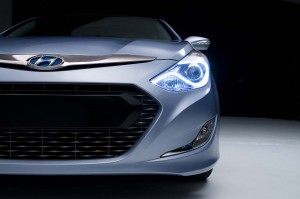The fuel economy of the average vehicle sold in the U.S. last year increased by a half mile per gallon over 2010 – in the process savings American motorists a collective 214 million gallons – or $722 million at the pump — according to new research.
The typical vehicle got 22.2 miles per gallon, reported data tracking service TrueCar.com, up from 21.7 mpg in 2010.
But there was a wide disparity among manufacturers. Chrysler, which is heavily dependent on vehicles like the big Ram pickup and Jeep Grand Cherokee SUV, averaged just 19.9 mpg a 0.2 mpg increase year-over-year. Korean carmaker Hyundai, which sells several crossover/utes but no truck models, averaged 26.6 mpg, a 1.3 mile per gallon gain.
Hyundai has been heavily promoting the mileage of its vehicles, four different models now rated by the EPA at over 40 mpg, and that “is right up there with design and with improvements in driving dynamics for boosting our sales,” said Hyundai Motor America CEO John Krafcik, referring to the 20% jump in demand the company reported in 2011.
Japanese makers, once leaders in fuel economy were several miles per gallon behind Hyundai, Honda averaging 24.2 mpg last year, according to TrueCar, a 0.7 mpg gain.
The maker’s top American executive, John Mendel, declared Honda’s goal of “being the leader in all segments in which we compete,” during an appearance at the Detroit Auto Show earlier this week.
Toyota averaged 23.6 mpg, up 0.2 miles per gallon, reported TrueCar, based on its analysis of total U.S. sales last year. And Nissan came in at 23.2 mpg, up 0.7 miles per gallon.
Ford was the most improved of the domestic manufacturers, with a 1.0 mpg gain to 21.4 mpg in 2011. The maker has been ramping up production of its high-mileage EcoBoost engines, including one offered in its F-Series pickups. In fact, about half of all its full-size trucks are now being ordered with V-6 engines, including one of the EcoBoost powertrains.
As for General Motors, its cars, trucks and crossovers averaged 20.9 mpg, up 0.5 miles per gallon over 2010.
“Automakers understand that fuel economy is an important value proposition for consumers,” said Jesse Toprak, Vice President of Industry Trends and Insights at TrueCar.com. “It may seem insignificant, but an increase of a half a mile per gallon in fuel economy translates to a reduction in fuel consumption of 214 million gallons or a savings of about $722 million in fuel annually in the U.S.”
The industry must meet a 35.5 mpg target by 2016, though with credits and adjustments the actual average works out several miles per gallon lower than that. Industry leaders agreed to support that target but there is more debate about the proposed 54.5 mpg goal for 2025, with hearings getting underway in Washington next week.
Some analysts believe that the only way to get there will be through the extensive use of advanced battery technology, though Chrysler CEO Sergio Marchionne this week pointed to the significant gains conventional gasoline engines are making with the use of direct injection, turbocharging, 8-speed gearboxes and other advances.
“There are so many inefficiencies (with the) combustion (engine) that will give us a greater opportunity to bring down fuel consumption than people think,” said Marchionne.

